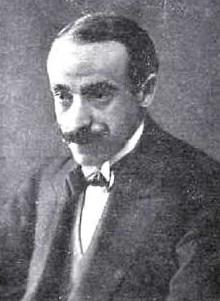Gregorio Martínez Sierra facts for kids
Quick facts for kids
Gregorio Martínez Sierra
|
|
|---|---|

Martínez Sierra around 1910
|
|
| Born | 6 May 1881 Madrid, Spain |
| Died | 1 October 1947 (aged 66) Madrid, Spain |
| Occupation | Writer, poet, dramatist, theatre director |
| Nationality | Spanish |
| Period | Modernism |
Gregorio Martínez Sierra (born May 6, 1881 – died October 1, 1947) was a Spanish writer, poet, and theatre director. He was very important in bringing new and exciting ideas to Spanish theatre in the early 1900s.
Contents
A Talented Writer and Playwright
Gregorio Martínez Sierra started his writing career when he was just 17 years old. His first book was a collection of poems called El poema del trabajo (which means 'The Poem of Work') published in 1898. He wrote other poetry books too, like Diálogos fantásticos ('Fantastic Dialogues') and Flores de escarcha ('Frost Flowers').
As a writer for the stage, Martínez Sierra was one of the few modern playwrights whose plays became very popular. Some of his most famous plays include La sombra del padre ('Shadow of the Father', 1909) and Primavera en otoño ('Spring in Autumn', 1911).
His play Canción de cuna ('Cradle Song', 1911) was a huge success. People loved it all over the Spanish-speaking world. An English version of this play even went to Broadway in New York City in 1927. Many of his plays were later made into movies. For example, Canción de cuna became a film in 1933.
It's important to know that Gregorio's wife, María Lejárraga, was also a talented writer. Many people believe she helped write a lot of his plays. After she published her memoir Gregorio y yo ('Gregorio and I') in 1953, it became clear that she played a very big part in creating his famous works.
Making Theatre Modern
Martínez Sierra was not just a writer; he also had a big impact as a publisher and theatre director. Through his publishing company, Renacimiento ('Rebirth'), he helped bring many important European writers to Spain. He translated works by famous authors like William Shakespeare and George Bernard Shaw.
Many of these translations were actually done by his wife, María Lejárraga. She was very good at languages, speaking French, English, Italian, and more. She had already published her own translations before and during her work with Gregorio.
In 1917, Gregorio Martínez Sierra became the director of the Teatro Eslava in Madrid. He stayed there until 1925. He turned this theatre into Spain's first "Art Theatre," which meant it showed new and exciting plays in a modern way. He invited many Spanish and foreign playwrights to perform there. It was at his theatre that the famous Spanish writer Federico García Lorca staged his very first play, El maleficio de la mariposa ('The Curse of the Butterfly'), in 1920.
Movies Based on His Works
Many films have been made based on Gregorio Martínez Sierra's plays and stories. Here are some of them:
- Mamá (1931)
- Primavera en otoño (1933)
- Una viuda romántica (1933)
- Cradle Song (1933)
- Yo, tú y ella (1933)
- Julieta compra un hijo (1935)
- Susana tiene un secreto (1935)
- Canción de cuna (Argentina, 1941)
- Tú eres la paz (Argentina, 1942)
- Los hombres las prefieren viudas (Argentina, 1943)
- El amor brujo (Spain, 1949)
- Canción de cuna (Mexico, 1953)
- Honeymoon (UK/Spain, 1959)
- Canción de cuna (Spain, 1961)
- Bewitched Love (Spain, 1967)
- El Amor brujo (Spain, 1986)
- Cradle Song (Spain, 1994)
Screenwriter for Films
Gregorio Martínez Sierra also wrote scripts for movies:
- La ciudad de cartón (1934)
- Dama de compañía (1940)
- La novia de la Marina (1948)
Film Director
He also directed some films himself:
- The Trial of Mary Dugan (1931, co-directed)
- Julieta compra un hijo (1935, co-directed)
- Canción de cuna (1941)
- Tú eres la paz (1942)
- Los hombres las prefieren viudas (1943)
See also
 In Spanish: Gregorio Martínez Sierra para niños
In Spanish: Gregorio Martínez Sierra para niños

